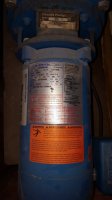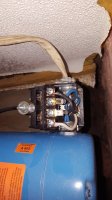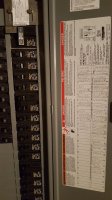mappley811
New Member
Hi guys,
I recently bought a house with a well. Coming from a house on public water, the intricacies of well equipment are a new topic for me. I'm looking to buy a standby generator for my house during power outages, and I wanted to find out if my pump was 115 or 230 volt.
First of all, the placard on the external (jet?) pump (photo 1) says that it can run on 115v or 230v. Fine, no problem. There's also a sticker on the pump housing (photo 2) that says it's wired for 230v. All good still. Here's where the questions begin.
First, I noticed that there are only 2 conductors coming into the wiring box; black and white, and two leaving the box into the pump (blue-black) (photo 2). To me, a hot and a neutral says 115v. So I checked the panel, and there is only a single pole, 20A breaker marked out for the pump (photo 3), which also tells me 115v.
So my questions are the following:
1. Is this definitely wired for 115v?
2. What are the advantages/disadvantages of the 115v vs. 230v option?
3. Should I be looking into rewiring this to 230v before I buy a generator? It will mean buying a 240v generator instead of a 120v, so I'd like to know now.
4. If I did rewire it to 230v, where would the third conductor go? I don't see an additional terminal available, and I can't make sense of the directions on the wiring diagram in photo 1.
Thanks in advance for any help!
I recently bought a house with a well. Coming from a house on public water, the intricacies of well equipment are a new topic for me. I'm looking to buy a standby generator for my house during power outages, and I wanted to find out if my pump was 115 or 230 volt.
First of all, the placard on the external (jet?) pump (photo 1) says that it can run on 115v or 230v. Fine, no problem. There's also a sticker on the pump housing (photo 2) that says it's wired for 230v. All good still. Here's where the questions begin.
First, I noticed that there are only 2 conductors coming into the wiring box; black and white, and two leaving the box into the pump (blue-black) (photo 2). To me, a hot and a neutral says 115v. So I checked the panel, and there is only a single pole, 20A breaker marked out for the pump (photo 3), which also tells me 115v.
So my questions are the following:
1. Is this definitely wired for 115v?
2. What are the advantages/disadvantages of the 115v vs. 230v option?
3. Should I be looking into rewiring this to 230v before I buy a generator? It will mean buying a 240v generator instead of a 120v, so I'd like to know now.
4. If I did rewire it to 230v, where would the third conductor go? I don't see an additional terminal available, and I can't make sense of the directions on the wiring diagram in photo 1.
Thanks in advance for any help!



